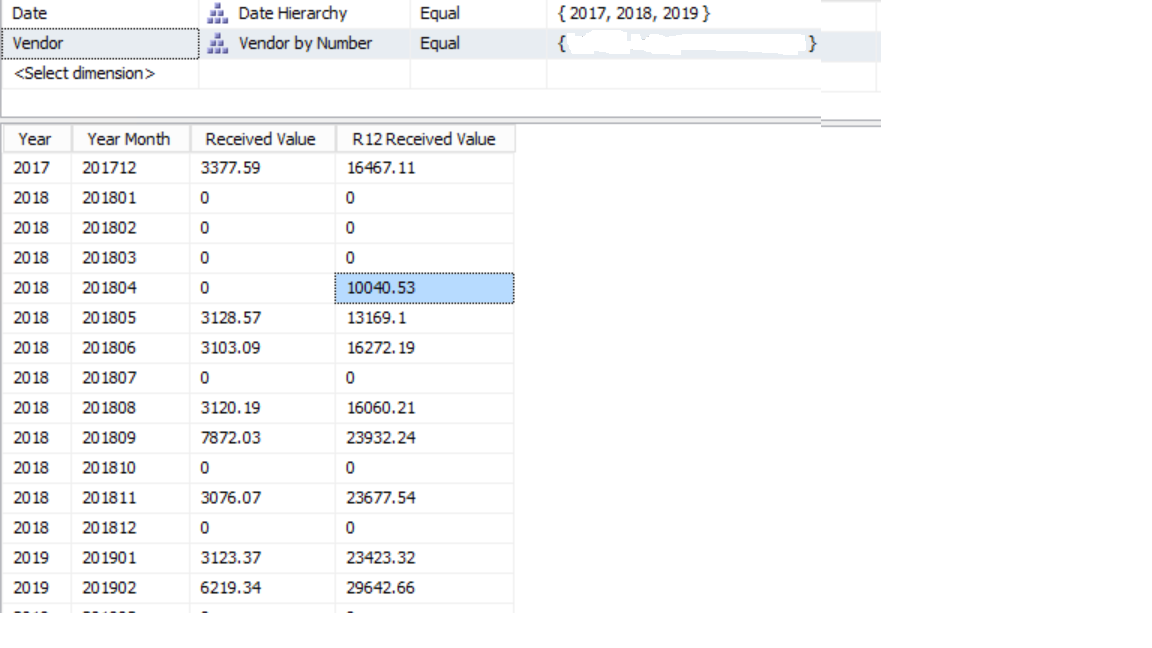Filling the blanks of a Rolling total with Previous non-blank value- DAX Query.
-
April 19, 2019 at 10:52 am
HI ,
I have a dimension Vendor and for this vendor i do not have any Sales Record for 2 Particular months (201901 & 201902)
I am calculating the Rolling 12 Months using the DatesInPeriod function as below and i see that the values for the Jan and Feb are displaying as Null for the Vendors.
So i replaced the Null values with Zero but still i am not able to get the Rolling 12 months values and displaying the Zero's for the Jan and Feb.Can someone help me with the DAX Query and Thanks in Advance 🙂
R12 Total Value:=CALCULATE(IF(ISBLANK(SUM('Fact Total'[Received])),0,SUM('Fact Total'[Received]) ),DATESINPERIOD('Date'[Date],CALCULATE(MAX('Fact Total'[Start_Date])),-12,MONTH ))
- This topic was modified 5 years, 7 months ago by Steve Dell.
-
April 19, 2019 at 12:30 pm
Can you provide more information? A screenshot of the results as well as the monthly numbers and your model would be helpful.
-
April 21, 2019 at 2:16 pm

- This reply was modified 5 years, 7 months ago by Steve Dell.
-
April 21, 2019 at 2:41 pm
Can you please provide more information, preferably a sample pbix sample file?
😎
-
April 22, 2019 at 5:15 am
its a SSAS Tabular project
-
April 22, 2019 at 6:01 am
If you Notice the image you will find that the 201807 , 201810, 201812 as Zero's.
The Rolling 12 Months should calculate as below respectively
201807 --- 16272.19
201810 --- 23932.24
201812 --- 23677.54
-
April 22, 2019 at 8:48 am
Steve Dell wrote:If you Notice the image you will find that the 201807 , 201810, 201812 as Zero's. The Rolling 12 Months should calculate as below respectively 201807 --- 16272.19 201810 --- 23932.24 201812 --- 23677.54
Cannot see any image, only a broken link that gives me a 404 error
😎
Since DAX code is "almost" identical in PowerBI, SSAS Tabular and Excel PowerPivot, it is a standard practice to share this kind of problems using the first or the last with sample data.
😎
-
April 22, 2019 at 9:09 am
Actual_DateReceivedVendor
201804250 10256
201805023128.57 10256
201806143103.09 10256
201808023120.19 10256
201809101657.27 10256
201809103107.38 10256
201809103107.38 10256
201811303076.07 10256
201901213123.37 10256
201902253109.67 10256
201902253109.67 10256
201902253109.67 10256
20190225-3109.6710256 -
April 22, 2019 at 11:46 am
Steve Dell wrote:Actual_DateReceivedVendor
201804250 10256
201805023128.57 10256
201806143103.09 10256
201808023120.19 10256
201809101657.27 10256
201809103107.38 10256
201809103107.38 10256
201811303076.07 10256
201901213123.37 10256
201902253109.67 10256
201902253109.67 10256
201902253109.67 10256
20190225-3109.6710256I know you don't know but when people say to include some sample data on this site, they mean in a readily consumable form. Please the the link in my signature line below for one way to do such a thing. It helps others help you because a whole lot of people on this site actually like to test their solutions before publishing them. Saves a huge amount of time on both sides.
--Jeff Moden
RBAR is pronounced "ree-bar" and is a "Modenism" for Row-By-Agonizing-Row.
First step towards the paradigm shift of writing Set Based code:
________Stop thinking about what you want to do to a ROW... think, instead, of what you want to do to a COLUMN.Change is inevitable... Change for the better is not.
Helpful Links:
How to post code problems
How to Post Performance Problems
Create a Tally Function (fnTally) -
April 25, 2019 at 10:04 am
This was removed by the editor as SPAM
-
April 25, 2019 at 10:12 am
This was removed by the editor as SPAM
-
April 25, 2019 at 10:17 am
--Fact Table with Actaul_Date, Received, Vendor columns
SELECT '20190225', '3109.67', '10256' UNION ALL
SELECT '20180614', '3103.09', '10256' UNION ALL
SELECT '20190121', '3123.37', '10256' UNION ALL
SELECT '20190225', '-3109.67', '10256' UNION ALL
SELECT '20181130', '3076.07', '10256' UNION ALL
SELECT '20180910', '1657.27', '10256' UNION ALL
SELECT '20190225', '3109.67', '10256' UNION ALL
SELECT '20180802', '3120.19', '10256' UNION ALL
SELECT '20180502', '3128.57', '10256' UNION ALL
SELECT '20180910', '3107.38', '10256' UNION ALL
SELECT '20190225', '3109.67', '10256' UNION ALL
SELECT '20180910', '3107.38', '10256' UNION ALL
SELECT '20180425', '0.00', '10256'
-- the date demenison has Year, Year_Month Columns -
April 25, 2019 at 10:20 am
I even tried to use the below code as example but no luck
CALCULATE (
COUNT ( ticketData[CreateDate] ),
FILTER (
ALL ( ticketData ),
ticketData[CreateDate] <= MAX ('Date'[date] )
)
)
-
April 25, 2019 at 5:01 pm
I think you may be over-complicating the DAX formula. This works for me:
Rolling 12 Month Total =
CALCULATE
(
[ReceivedAmount]
, DATESINPERIOD
(
'Date'[Date]
, LASTDATE('Date'[Date])
, -12
, MONTH
)
)Where [ReceivedAmount] is a simple measure that sums up the the amounts.
Make sure that your Date dimension is contiguous and also that it is marked as the Date Table in PBI Desktop. This is required for time intelligence to work.
Viewing 14 posts - 1 through 13 (of 13 total)
You must be logged in to reply to this topic. Login to reply
